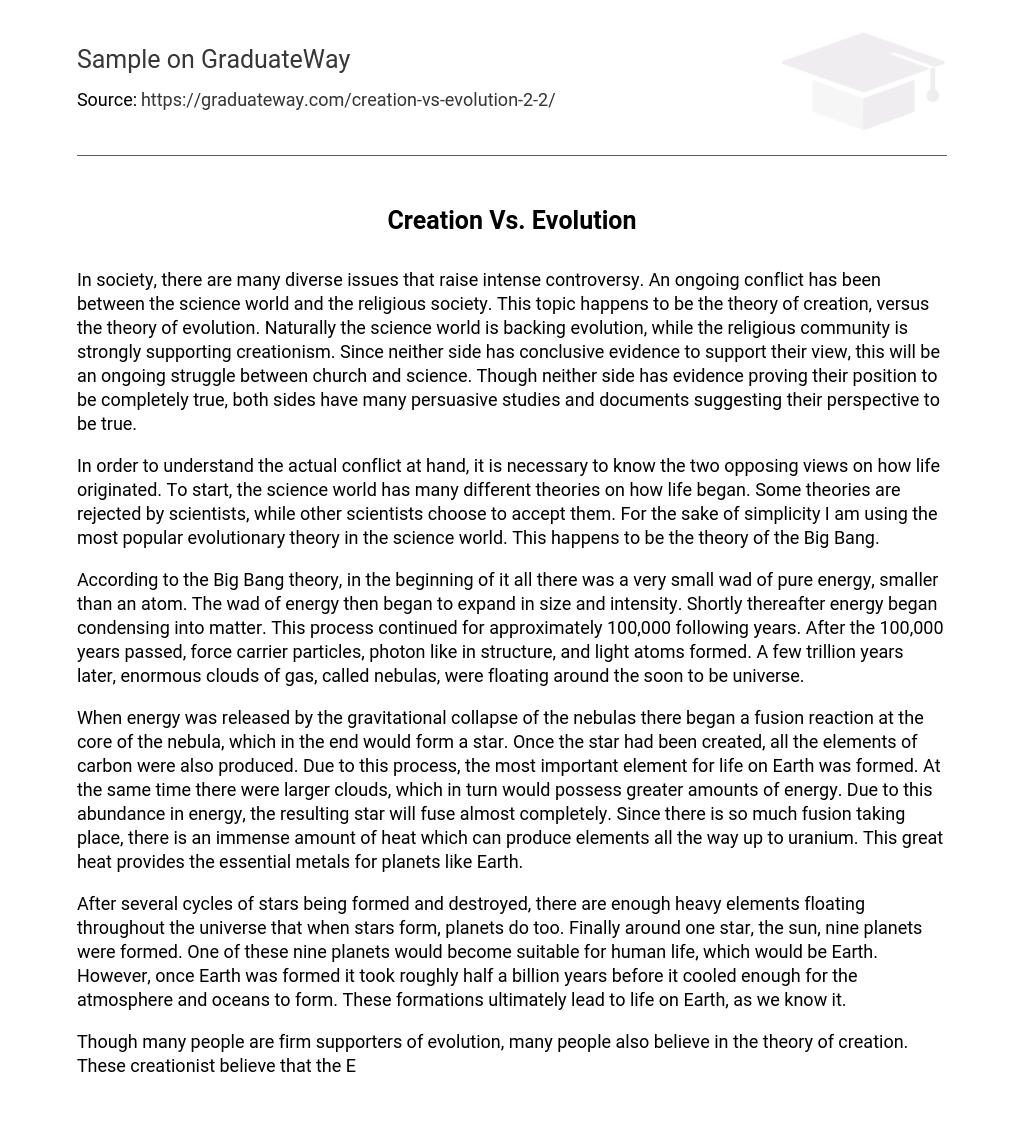The theory of creation and the theory of evolution have sparked intense controversy in society. The science world supports evolution while the religious community is in favor of creationism. Due to lack of conclusive evidence, this conflict between church and science will persist. However, both sides present persuasive studies and documents to support their respective viewpoints.
To fully understand the current conflict, it is essential to grasp the diverse viewpoints on the origin of life in the scientific community. Scientists have different theories, with some being rejected and others embraced. For simplicity, I will concentrate on the widely accepted evolutionary theory called the Big Bang.
The Big Bang theory proposes that initially, there was a minuscule amount of pure energy, smaller than an atom. This energy started to expand and grow in intensity, eventually condensing and developing into matter. This process lasted approximately 100,000 years. At the end of this phase, force-carrying particles resembling photons emerged along with light atoms. Nebulas, huge gas clouds, drifted throughout the universe for countless trillions of years.
When nebulas undergo gravitational collapse, energy is released, initiating a fusion reaction within the nebulas’ cores that eventually leads to the formation of stars. During this process, carbon elements are also generated, becoming vital for life on Earth. Simultaneously, there exist larger clouds that possess higher energy levels. Consequently, the resulting stars formed from these clouds undergo a nearly complete fusion. This intense fusion process generates a significant amount of heat, enabling the production of elements as heavy as uranium. Thus, this abundant heat is responsible for providing the crucial metals required for planets such as Earth.
After undergoing several cycles of star formation and destruction, the universe now contains a significant abundance of heavy elements. As a result, when stars are born, planets also form. Eventually, our sun became the focal point around which nine planets revolved, with Earth being one of them – eventually becoming suitable for humans to live on. Nevertheless, it took approximately 500 million years for Earth to cool down enough for its atmosphere and oceans to come into existence. These formations ultimately allowed life as we know it today to flourish on our planet.
Although there are individuals who support evolution, there is a significant number of people who believe in creationism. Creationists hold the belief that God created the Earth and all living beings. To fully understand creationists’ perspective, it is essential to explore their beliefs.
In the beginning, God created the heavens and the earth. The earth was bare until God commanded, “Let there be light!” When light appeared, God saw that it was good. He then declared, “Let there be an expanse in the midst of the waters, separating the waters from the waters.” One set of waters belonged to the heavens, while the other remained on earth. All of this occurred as God was just getting started. Oncefilled with water, God proceeded to separatefrom land.
God, with only seven days to complete his task, had to keep moving. To accomplish this, he commanded, “Let the earth sprout vegetation, plants yielding seed, and fruit trees bearing fruit after their kind, with seed in them on the earth.” And instantly, it occurred. Consequently, the third day concluded.
God created lights in the expanse of the heavens on the fourth day. These lights were meant to separate day from night, serve as signs, and mark seasons, days, and years. They also provided illumination on earth. God made two great lights – one to govern the day and one to control the night. This completed God’s work on the fourth day.
God established the necessities and dedicated the fifth and sixth days to the creation of animals and humans. To fulfill this duty, he granted his creatures the ability to reproduce and multiply. The sixth day came to an end.
On the seventh day, God took a break and admired his creations, which is why Sunday is still considered a day of rest.
After introducing the two objective theories advocated by both evolutionists and creationists, it becomes crucial to examine the weaknesses within each theory. Initially, the evolutionist theory displays multiple evident flaws that creationists capitalize on to reinforce their own convictions. These flaws are often scrutinized by creationists, particularly in matters pertaining to social issues.





